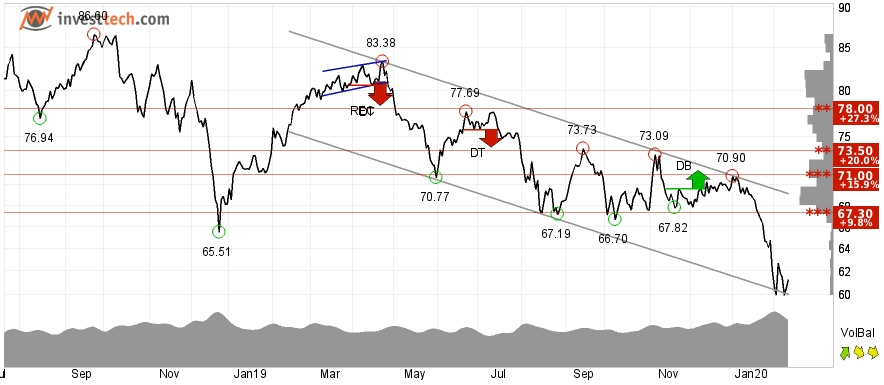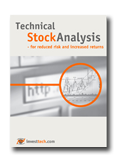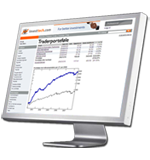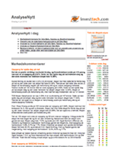Investtech Research: Negative excess return from stocks in falling trends
Published 14 February 2020
"Trend" is a key concept in technical analysis. Technical analysis theory states that stocks in falling trends will continue to fall within the trend, and new research results from Investtech largely confirm this theory.
Trends are one of the most important elements of technical analysis. They are visual and intuitive and describe in which direction a stock is moving. A rising trend indicates lasting and increasing optimism among investors, often as a result of a great deal of positive news about the stock.
Identifying a trend requires studying the price movements. Stock prices rarely move in a straight line. Instead they move in a series of tops and bottoms. Drawing a straight line through two or more rising bottoms produces the support line in a rising trend. Continue to draw a line parallel to the support line through the rising tops. This line is called the trend’s resistance line. Support and resistance lines combined make up the trend. The trend gives the rate of increase for the stock price, and extrapolating trend lines gives the price target for the stock. There are gradual transitions between rising trends, horizontal trends and falling trends.
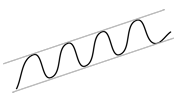
Figure 1: Rising trend.
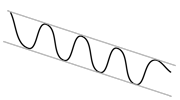
Figure 2: Falling trend.
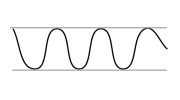
Figure 3: Horizontal trend.
Investtech’s algorithms identify trends for you. We have developed automatic algorithms for trend identification that find the "best" trend in the chart every day, taking into account trend density, number of data points near floor and ceiling, etc. In a medium term Investtech chart with 18 months' price history some 80,000 different trend alternatives are assessed every day. These are assigned a score and the trend with the highest score is selected. A current example may be Exxon Mobil, which is in a falling trend in the short, medium and long term per 12 February.
Figure 4:Exxon Mobil (XOM.DJIA) Close: 61.27 (+0.74), Feb 12, 2020
Our subscribers can find stocks with these negative signals using for instance the tool Top50.
We wanted to study the statistical results yielded by sell signals from falling trends and therefore studied return from Norwegian, Swedish, Danish and Finnish stocks following buy and sell signals from rising and falling trends identified in Investtech’s price charts in the short, medium and long term. We had up to 23 years of data, from 1996 to 2018. We defined a sell signal as the first day a stock entered a falling trend, or when the stock was in a falling trend and it had been more than 22 days since the previous signal.
The chart below shows average price development following sell signals from falling trends identified in Investtech’s medium term price charts in the Nordic markets. The signals are triggered on day 0. Only days when the exchange is open are included, so 66 days equal approximately three months. The thick red line shows the development of sell signal stocks. The shaded areas are the standard deviation of the calculations. The thin red line shows benchmark development in the same period as the sell signal stocks.
Stocks in short term falling trends rose on average 0.4 per cent in one month. Compared to benchmark in the same period, stocks in falling trends did 0.3 percentage points worse, which equals an annualised negative excess return of 4.0 percentage points.
Stocks in medium term falling trends underperformed compared to benchmark in the following three months. Negative excess return after three months was on average 1.3 percentage points, which equals an annualised negative excess return of 5.1 percentage points.
Stocks in long term falling trends rose on average 1.7 per cent in three months. Compared to benchmark in the same period, stocks in falling trends did 1.4 percentage points worse, which equals an annualised negative excess return of 5.6 percentage points.
The time period for the study is fairly long, the quality of the data is considered to be good and the algorithms used are entirely automatic. Statistical measures suggest a high degree of significance. The results are similar across the four markets and signal strength variation over time has been small. This indicates that we have identified real effects in the markets, which persist over time.
There is high likelihood that trend signals will give good indications of how stocks will develop also in the future. Stocks in falling trends are expected to underperform vs benchmark.
Please find more details and results in the research reports here:
Rising and falling trends, short term
Rising and falling trends, medium term
Rising and falling trends, long term
Keywords: h_TF.
Geschreven door

Analist
in Investtech
Related articles:
Excess return after break upwards from rising trend
Negative excess return after breaks downwards from falling trends
Excess return from stocks in rising trends
Negative excess return from stocks in falling trends
Insight & skills:
"Investtech analyseert de psychologie in de markt en geeft u iedere dag concrete trading-voorstellen."

Partner & Senior Advisor - Investtech
Investeringsaanbevelingen worden gedaan door Investtech.com AS ("Investtech"). Investtech garandeert geen volledigheid of juistheid van de analyses. Eventuele fouten in de aanbevelingen, koop- en verkoopsignalen en mogelijke negatieve gevolgen hiervan zijn geheel het risico van de belegger. Investtech neemt geen enkele verantwoordelijkheid voor verlies, direct of indirect, als gevolg van het gebruik van Investtechs analyses. Meer informatie omtrent Investtechs analyses kunt u vinden op disclaimer.
Investeringsaanbevelingen worden gedaan door Investtech.com AS ("Investtech"). Investtech garandeert geen volledigheid of juistheid van de analyses. Eventuele fouten in de aanbevelingen, koop- en verkoopsignalen en mogelijke negatieve gevolgen hiervan zijn geheel het risico van de belegger. Investtech neemt geen enkele verantwoordelijkheid voor verlies, direct of indirect, als gevolg van het gebruik van Investtechs analyses. Meer informatie omtrent Investtechs analyses kunt u vinden op disclaimer.


 Oslo Børs
Oslo Børs Stockholmsbörsen
Stockholmsbörsen Københavns Fondsbørs
Københavns Fondsbørs Helsingin pörssi
Helsingin pörssi World Indices
World Indices US Stocks
US Stocks Toronto Stock Exchange
Toronto Stock Exchange London Stock Exchange
London Stock Exchange Euronext Amsterdam
Euronext Amsterdam Euronext Brussel
Euronext Brussel DAX
DAX CAC 40
CAC 40 Mumbai S.E.
Mumbai S.E. Commodities
Commodities Currency
Currency Cryptocurrency
Cryptocurrency Exchange Traded Funds
Exchange Traded Funds Investtech Indices
Investtech Indices